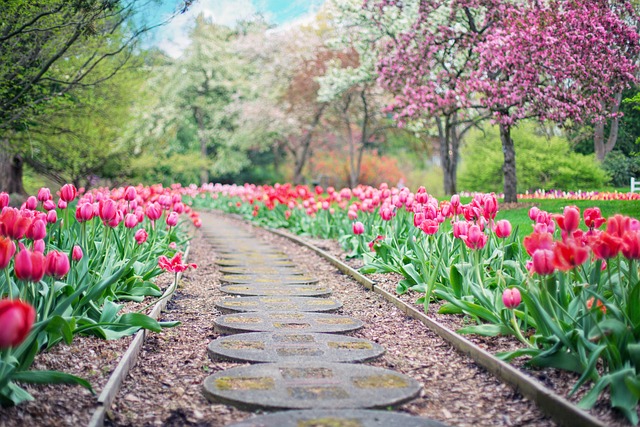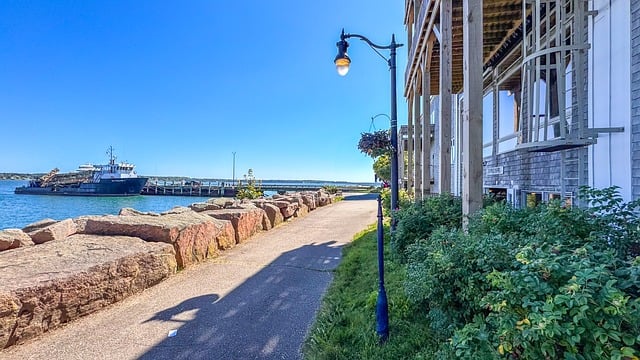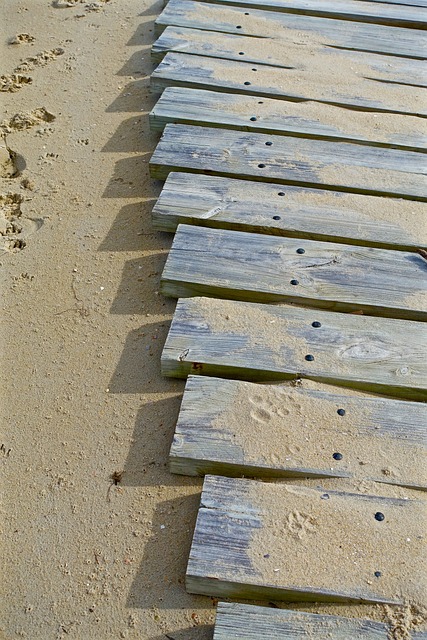When designing a custom walkway or pathway for your outdoor space, it's crucial to consider the property's topography, landscape features, and intended use to ensure safety, functionality, and visual harmony. Factors like terrain contours, soil stability, drainage, climate, maintenance needs, and user accessibility must be carefully assessed. Material selection should prioritize durability and sustainability, with options like permeable paving aiding in stormwater management. The integration of lighting, seating, landscaping, and artistic features enhances the walkway's aesthetic appeal and user experience. A well-designed pathway not only meets practical needs but also complements its environment, reflecting eco-conscious choices and regional character. Professional installation is key for longevity and safety, with attention to drainage and slope to prevent water damage. The final result should be a seamless blend of form and function, enriching the user's experience and contributing positively to the overall landscape design, all while ensuring the walkway or pathway serves its purpose effectively.
Embarking on the creation of a custom walkway or pathway can transform your outdoor space into a harmonious blend of form and function. This article delves into the essential aspects of designing and installing a bespoke walkway that not only complements your property’s aesthetics but also stands the test of time. From assessing your space to selecting materials, and from planning design elements to ensuring safety and sustainability, each step is crucial for achieving an enduring and visually appealing pathway. Join us as we navigate through the process of crafting a walkway that will serve as a durable and inviting gateway to your home or garden.
- Assessing Your Space: Planning for Custom Walkways and Pathways
- – Evaluating the site conditions
- – Determining the purpose and function of the walkway/pathway
- – Considering material choices and design elements
Assessing Your Space: Planning for Custom Walkways and Pathways

When contemplating the addition of custom walkways or pathways to your outdoor space, a thorough assessment of your environment is paramount. Consider the existing topography and how it can inform the design; natural undulations can inspire flowing lines in your walkway, while slopes may necessitate retaining walls for safety and accessibility. The desired function of the pathway also plays a crucial role; whether it’s a leisurely stroll through a garden or an efficient route from one point to another, this will influence its dimensions and materials.
In the planning phase, take into account the intended use and the users themselves. Will children be playing near these walkways? Are there areas that see heavy foot traffic that require more durable surfaces? The choice of materials such as concrete, brick, or natural stone can vary based on aesthetic preferences, but also on maintenance requirements and environmental conditions. Proper drainage should be integrated to ensure the pathway remains safe and usable throughout the year, especially in regions with significant rainfall or snow. By carefully considering these factors, you can create a walkway or pathway that is both functional and enhances the beauty of your landscape.
– Evaluating the site conditions

When embarking on a custom walkway or pathway design and installation project, the first step is to meticulously evaluate the site conditions. This includes assessing the terrain’s topography, soil stability, and drainage patterns to ensure the walkway’s longevity and safety. Geotechnical surveys may be necessary to understand the subsurface conditions, which can influence material selection for a stable foundation. Additionally, considering the intended use, foot traffic volume, and environmental exposure will guide the choice of durable materials that can withstand the elements and wear over time. Proper site analysis also includes evaluating accessibility needs, ensuring the walkway design accommodates all users, enhancing both mobility and aesthetics within the landscape.
Upon a thorough understanding of the site’s characteristics, the next phase involves selecting appropriate materials and design features that complement the surrounding environment while meeting functional requirements. Eco-friendly options like permeable paving can manage stormwater runoff, reducing environmental impact and promoting sustainable land use practices. The design should also incorporate elements such as lighting, seating, or landscaping to create a harmonious and inviting space. Furthermore, incorporating artistic elements like mosaics or patterns can add a unique touch that reflects the character of the area or the preferences of the users. These considerations ensure that the walkway or pathway not only serves its purpose but also enhances the aesthetic appeal of the property.
– Determining the purpose and function of the walkway/pathway

When embarking on the creation of a custom walkway or pathway, the first step is to ascertain its purpose and function within the space it will occupy. Whether the pathway serves as a connecting element between different areas of a landscape, a safety route during outdoor events, or an ornate feature that complements the garden’s aesthetics, this determination guides subsequent design choices. The choice of material, from eco-friendly wood to durable concrete pavers, and the integration of elements like lighting or seating, are all informed by the intended use. For instance, a pathway meant for accessibility may require a different gradient and surface texture than one designed for scenic strolls. Similarly, the walkway’s alignment and curvature can be tailored to enhance visibility of natural features or to harmonize with the surrounding environment, thereby creating an organic and functional space that invites exploration and use.
In addition to practical considerations, the custom design of a walkway or pathway also involves aesthetic planning. The choice of materials, color palettes, and textures contributes to the visual appeal and cohesion with existing structures or natural elements. For example, the use of local stone can pay homage to the region’s geology while also reducing the environmental impact. The integration of plants along the edges or within the path itself can soften the transition between hardscape and greenery, creating a seamless blend that feels both designed and natural. The goal is to design a walkway or pathway that not only serves its intended purpose but also elevates the user’s experience through tactile, visual, and olfactory sensations.
– Considering material choices and design elements

When designing a custom walkway or pathway, material selection plays a pivotal role in determining both aesthetics and functionality. Homeowners and landscape architects often choose from a variety of materials such as natural stone, concrete pavers, or brick to create a surface that complements the surrounding environment while accommodating foot traffic effectively. The texture and color of these materials can enhance the visual appeal of outdoor spaces, serving as a harmonious transition between indoor and outdoor areas. Additionally, the design elements such as curvature, patterns, and lighting integrated into the pathway not only add character but also guide and enhance the user experience. For instance, incorporating lights along the pathway can extend its usability into the evening hours, transforming a simple walkway into a focal point that connects different areas of a property.
Installation techniques are as crucial as material choices when it comes to ensuring the longevity and safety of a walkway or pathway. Proper drainage and slope considerations prevent water accumulation, which can compromise both the structure and the user’s comfort. Skilled contractors employ best practices to excavate, lay the base, and set the materials with precision, ensuring a level and durable surface that stands up to the elements and heavy use. The integration of garden elements or architectural features alongside the pathway can further enhance its appeal, creating a seamless blend of form and function that elevates the overall landscape design.
In crafting a bespoke walkway or pathway, the nuances of your environment and the objectives for its use play pivotal roles in shaping the final design. By carefully evaluating site conditions and thoughtfully choosing materials and design elements, these passageways become more than mere connections between points—they become integral features that enhance both functionality and aesthetic appeal. Whether your project aims to harmonize with nature or infuse a touch of elegance into your landscape, the meticulous planning process ensures that each custom walkway or pathway meets its unique purpose. For those seeking to elevate their outdoor spaces with a tailored design, the key lies in understanding the intricate balance between form and function. As such, investing in a well-designed walkway or pathway not only adds character to your property but also facilitates safe and accessible passage for years to come.
